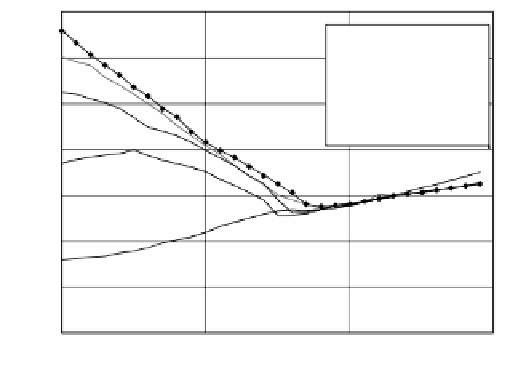Environmental Engineering Reference
In-Depth Information
70
Rimmed steel
3.5% Ni steel
Killed steel
18-8 stainless steel
Low-carbon steel
60
50
40
30
20
10
0
0
500
1000
1500
Temperature,
°
C
FIGURE 5.35
Examples of the relationship between steel temperature and thermal
conductivity.
5.2.3 C
ALCULATION
OF
P
REHEATED
A
IR
T
EMPERATURES
AND
E
XHAUST
G
AS
T
EMPERATURES
AFTER
H
EAT
E
XCHANGE
The regenerative heat exchanger simulator carries out a non-steady convergence
calculation requiring extensive computing time. It should also be noted that reheating
furnaces have multiple regenerative heat exchangers and it is very difficult to do the
calculation combining all the exchangers. Therefore the present reheating furnace
simulator does the calculation using as input data the heat recovery rates of heat
exchangers obtained by the regenerative heat exchanger simulator. Air and the
specific heat of exhaust gas are the nonlinear functions of temperatures. Therefore,
a simple multiplication of the exhaust gas temperature by the heat recovery rate does
not give the correct temperature of the preheated air.
As
Figure 5.36
shows, (a) the sensible heat of exhaust gas is obtained from the
exhaust gas temperature, and (b) the sensible heat of the preheated air is obtained
from the heat recovery rate from this sensible heat of exhaust gas. Next, (c) the
preheated air temperature is obtained from the sensible heat of the preheated air
where a convergence calculation is also carried out to obtain the heat balance, taking
into consideration also the condition that the exhaust gas temperature is greater than
the preheated air temperature. This method is applied both to regenerative heat
exchangers and to recuperators.
5.2.4 R
ADIATION
H
EAT
FROM
THE
F
URNACE
B
ODY
AND
H
EAT
L
OSS
BY
C
OOLING
W
ATER
The radiation heat from the furnace body of this zone (I) is calculated by Formula
5.1. The temperature simulator is programmed in the form of a box to simplify its









Search WWH ::

Custom Search